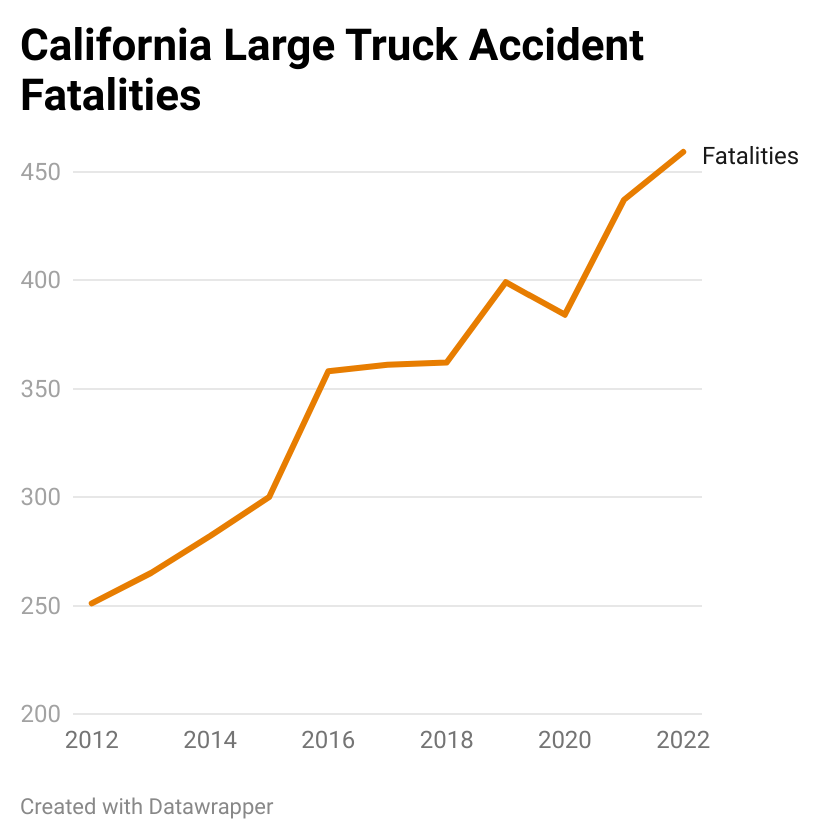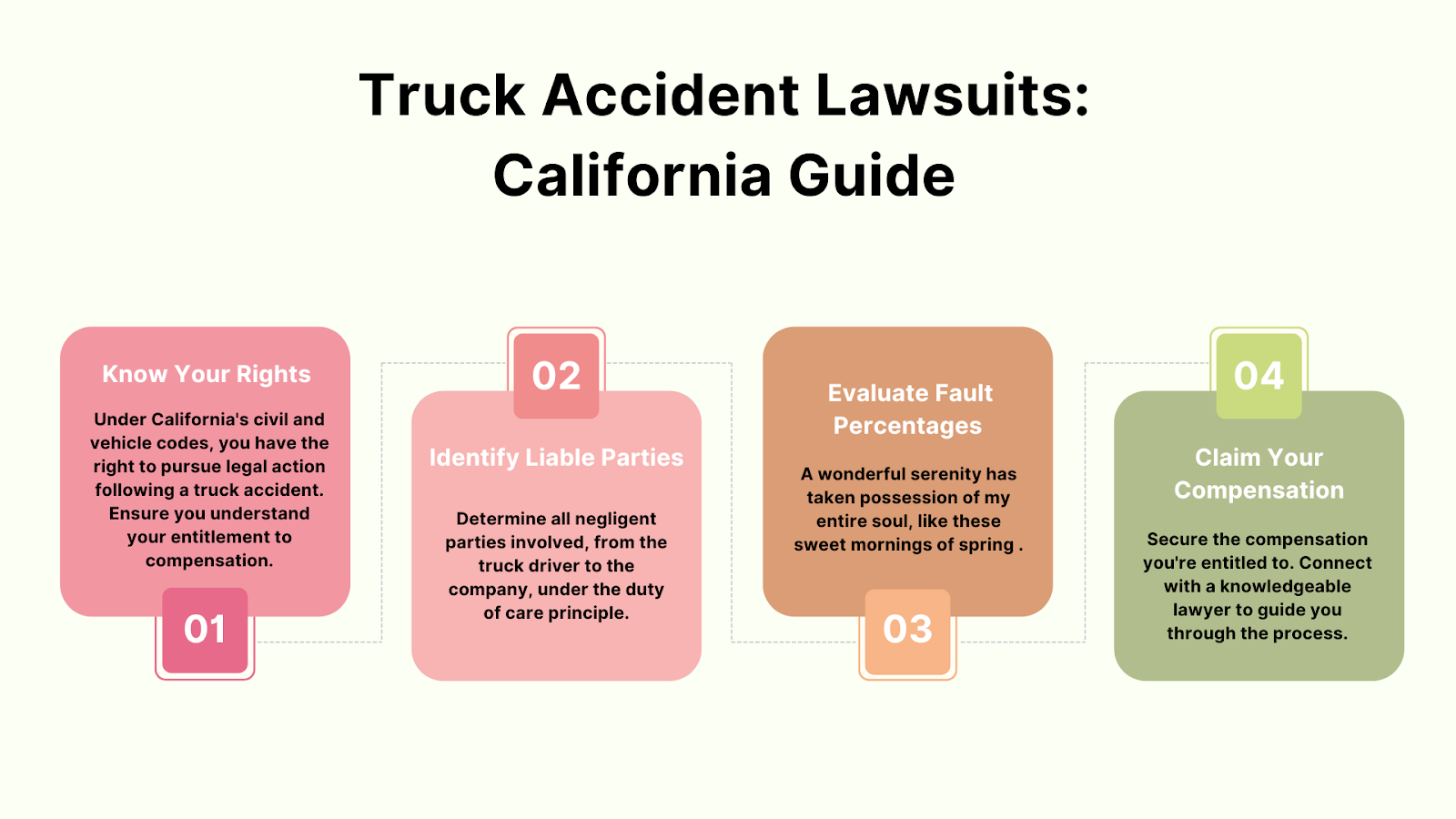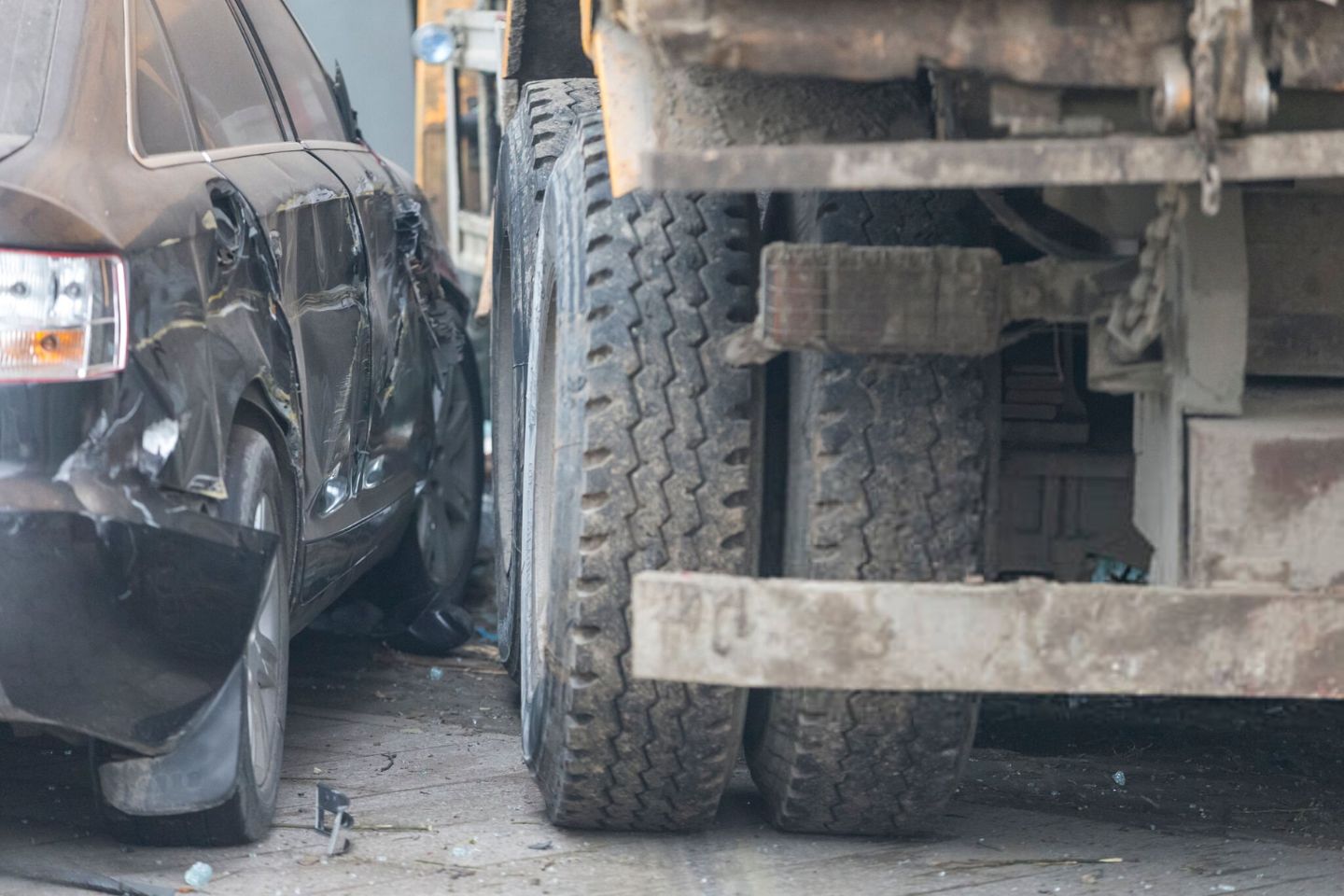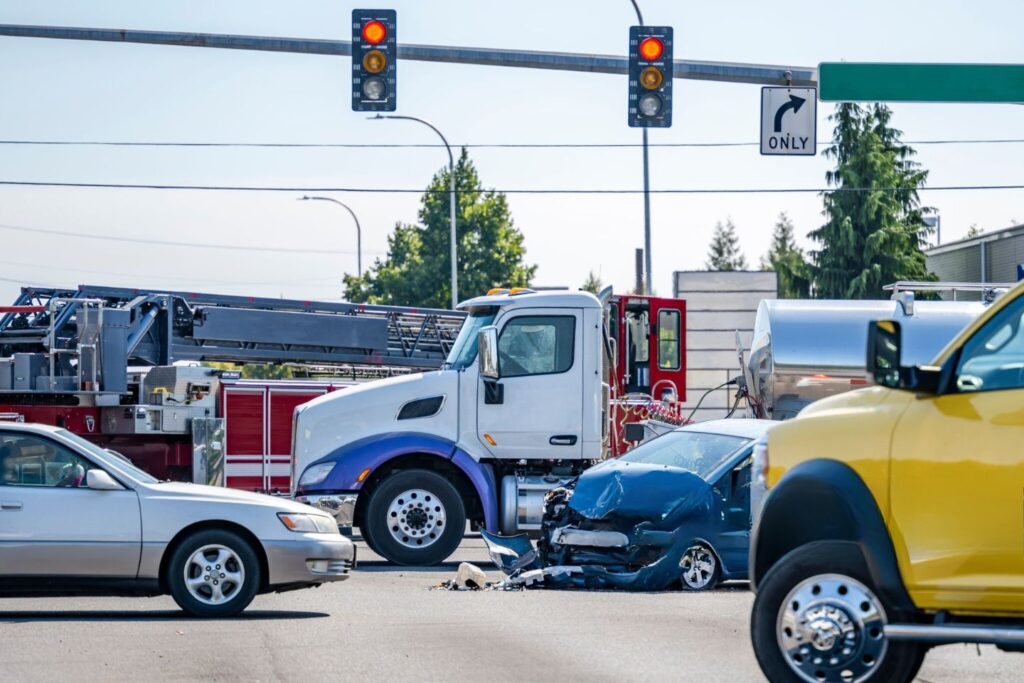California’s roads have consistently seen a high rate of truck accidents, maintaining its rank as the second-highest in the nation from 2020 to 2022.
In 2022 alone, the state faced a daunting 13,603 truck accidents. Out of these, 459 tragically resulted in fatalities, while 4,172 led to physical injuries. The consistent rise in fatalities over the years highlights the critical need for improved safety measures and awareness on California roads.


With such alarming numbers, it’s clear why understanding the dynamics of California truck accidents is vital, especially for those who travel its roads regularly. This article will explore the causes, repercussions, and legal intricacies of these accidents, offering essential insights for anyone navigating this challenging landscape.
- Why Is California Vulnerable to Truck Accidents?
- Can You File a Lawsuit for a Truck Accident in California?
- Common Grounds for Truck Accident Lawsuits
- Settlement vs. Litigation: What’s the Best Recourse?
- When Should You File a Lawsuit?
- How to Strengthen Your Personal Injury Case?
- Need Assistance With Your California Truck Accident Case?
Why Is California Vulnerable to Truck Accidents?
The dynamic mix of densely populated cities, extensive highway networks, and bustling commercial trade creates a hotbed for California traffic accidents. The increased risk of truck accidents, in particular, may rise from:
- High Traffic Volume: California’s roads rank among the nation’s busiest. In cities like Los Angeles and San Francisco, heavy traffic is a daily reality. TRIP reports that over 87% of California’s urban interstates are congested, significantly increasing the chances of vehicular accidents.
- Economic Hub: In 2021, the California Department of Motor Vehicles reported 15.9 million commercial and private vehicles registered within the state. This immense volume of traffic, integral to the movement of goods and daily commutes, substantially raises the potential for truck-related incidents on California’s roads.
- Diverse Weather Conditions: The varied climate of California, ranging from the fog-bound coastlines to the intense heat of desert terrains, presents unique challenges for drivers, influencing the likelihood of vehicle crashes.
- Driver Fatigue and Pressure: The demanding schedules faced by truck drivers can lead to fatigue, which has been recognized as a significant factor in many commercial motor vehicle collisions across California.
- Extensive Freeway System: The state boasts an extensive network of freeways, with trucks frequently traveling at high speeds. The National Highway Traffic Safety Administration (NHTSA) notes that in high-speed collisions involving trucks, the severity of injuries and property damage is considerably higher, especially if the driver is distracted or fatigued.
Can You File a Lawsuit for a Truck Accident in California?


If you’re dealing with the aftermath of a truck accident in California, it’s natural to wonder about your legal recourse. Indeed, you have the right to file a lawsuit, but it’s important to understand the specific legal landscape that governs these cases in the state.
Negligence and Duty of Care
In truck accident cases in California, the concept of negligence is central. Under California Civil Code Section 1714(a), every individual and entity is legally obligated to exercise reasonable care in managing their property or themselves. This law can be helpful in truck accidents where multiple parties might be involved. For instance, the responsibility doesn’t just rest with the truck driver; it extends to the trucking company, cargo loaders, and even manufacturers of truck parts.
Proving negligence requires a thorough investigation. Legal teams often look into the truck driver’s history for past violations, evaluate the trucking company’s hiring practices and training programs, and analyze maintenance records. Gathering and presenting this evidence is key to establishing a breach of duty that led to the accident.
Comparative Fault System
The “pure comparative negligence” rule in California, as highlighted in Li v. Yellow Cab Co., 13 Cal.3d 804 (1975), offers a unique approach to determining fault. This doctrine permits the court to evaluate the degree of fault of each involved party and then allocate the damages accordingly.
For example, if a commercial truck collided with a passenger vehicle, and the truck driver was found to be 70% at fault due to fatigue, but the passenger car’s driver was 30% at fault due to failing to signal a lane change, the total damages awarded to the passenger car’s driver would be reduced by their 30% share of fault.
This approach ensures that compensation accurately reflects the complexities of the accident. All parties involved in a collision must understand how fault is assessed and its impact on potential compensation. The Personal Injury Center can connect you with an expert attorney to advocate for your rightful compensation.
Common Grounds for Truck Accident Lawsuits


When pursuing a lawsuit following a truck accident in California, understanding the common grounds on which these lawsuits are based is crucial.
Here are the primary areas often explored in these legal battles:
Driver Error:
- Speeding: Exceeding the speed limit or driving too fast for conditions is a frequent cause of truck accidents. The larger mass of trucks means a greater impact in collisions, often leading to more severe injuries.
- Distracted Driving: This includes any activity that diverts attention from driving, such as using a cell phone, eating, or adjusting the radio. Given the size and weight of trucks, even a momentary lapse can have catastrophic consequences.
- Driving Under the Influence (DUI): Operating a truck under the influence of alcohol or drugs is not only illegal but significantly increases the risk of causing an accident.
Company Liability:
- Violations of Regulations: Trucking companies are obligated to adhere to federal and state regulations, including limits on cargo loads and mandatory vehicle maintenance. Failure to comply can lead to accidents, making the company liable.
- Inadequate Training: Companies must provide proper training to their drivers. Inadequate training on safe driving practices and truck operation can be grounds for a lawsuit if it leads to an accident.
- Forced Driving Hours: Companies pushing drivers to work beyond the legal hours-of-service limits can result in driver fatigue, a known cause of accidents.
Product Liability:
- Defective Truck Parts: If a truck accident is caused by a defective part, such as brake failure or tire blowouts, the manufacturer of that part can be held liable.
- Failure to Recall: Manufacturers are also responsible for recalling any parts known to be hazardous. If an accident is linked to a part that should have been recalled, this can be a basis for a product liability claim.
Settlement vs. Litigation: What’s the Best Recourse?
In the wake of a truck accident in California, deciding between settling out of court or going forward with litigation is a pivotal choice. This decision is shaped by specific aspects of your case, the extent of your injuries, and what you personally prefer.
Settlement
Choosing to settle can lead to a quicker resolution, offering a more controlled and predictable outcome while maintaining privacy. Settlements are typically private, providing discretion far removed from the public eye of court proceedings.
Steps in the Settlement Process:
- Assessment of Injuries: The severity of injuries plays a critical role in influencing the settlement amount, as it needs to cover all related expenses.
- Negotiation: An experienced attorney will negotiate on your behalf, aiming to reach a settlement that adequately compensates for your losses.
- Agreement: Once a settlement is reached, it concludes the legal process, and the agreed compensation is paid out.
However, settlements might sometimes result in lower compensation compared to what could be awarded in a trial, often involving a negotiation of the claim’s value.
Litigation
Litigation may lead to higher compensation, especially in clear-cut cases of negligence with severe injuries. It also brings the case into the public domain, ensuring accountability.
Steps in the Litigation Process:
- Filing a Lawsuit: This initiates the legal proceedings, often after settlement negotiations have failed or are deemed unsatisfactory.
- Discovery and Evidence Gathering: Collecting robust evidence to prove negligence is crucial for a strong case.
- Trial: The case is presented before a judge or jury, who will decide the outcome based on the evidence and arguments presented.
Litigation, while offering the potential for higher compensation, can be lengthy, uncertain, and emotionally taxing. The outcome is unpredictable, and it can involve an intense scrutiny of all details related to the accident and injuries.
When Should You File a Lawsuit?
Understanding the statute of limitations is crucial in determining when to file a lawsuit for a truck accident in California. As per the California Code of Civil Procedure Section 335.1, you typically have two years from the date of the accident to initiate a personal injury claim.
However, exceptions can apply, such as the”discovery rule.” In some cases, the true extent of injuries or the fact that an injury was caused by the accident might not be immediately apparent. If injuries become apparent after some time, or if the relationship between the injury and the accident is only recognized later, the statute of limitations, may commence from the time these facts are discovered, rather than from the day the accident occurred.
If you’re uncertain about when to take legal action or how the discovery rule might apply to your situation, The Personal Injury Center is ready to assist. Our team will evaluate your case and connect you with the right attorney, ensuring you meet all critical deadlines for your claim.
How to Strengthen Your Personal Injury Case?


When pursuing a personal injury claim after a truck accident in California, strengthening your case is essential to achieving a successful outcome. Here are essential steps you can take:
Gather Comprehensive Evidence
The foundation of a strong personal injury case lies in the evidence you collect. Immediately after the accident, it’s crucial to take detailed photos and videos of the scene, capturing vehicle positions, damage, road conditions, and any relevant environmental factors.
Securing contact information and statements from witnesses at the scene can also provide important support for your version of events. Additionally, obtaining a copy of the police report is essential, as it provides an official account of the incident.
Seek Immediate Medical Attention
Even if your injuries appear minor, seeking medical attention immediately after the accident is vital. A medical professional’s evaluation not only ensures your well-being but also serves as critical documentation of your injuries.
Consistently following up with prescribed treatments and therapies establishes a documented link between the accident and your injuries, reinforcing the validity of your claim.
Be Mindful of Communications
The way you communicate about your accident can significantly impact your case. Exercise caution when discussing the incident with insurance adjusters, as these conversations can influence the settlement offer. Additionally, be aware of your social media activity; avoid posting any information that could be construed as contradictory to your claim.
Consult with a Personal Injury Attorney
Engaging an experienced personal injury attorney is perhaps the most crucial step in strengthening your case. A skilled lawyer can guide you through the legal process, provide strategic advice, and handle negotiations to ensure you receive fair compensation.
Need Assistance With Your California Truck Accident Case?
Navigating the aftermath of a truck accident in California can be daunting, but The Personal Injury Center is here to help. We provide expert guidance and support to those facing the complexities of such incidents.
Contact us to be connected with an experienced personal injury attorney who specializes in California truck accidents. Our goal is to empower you with the necessary information and resources, ensuring you’re well-equipped to make informed decisions about your legal options.
Key Takeaways
|



